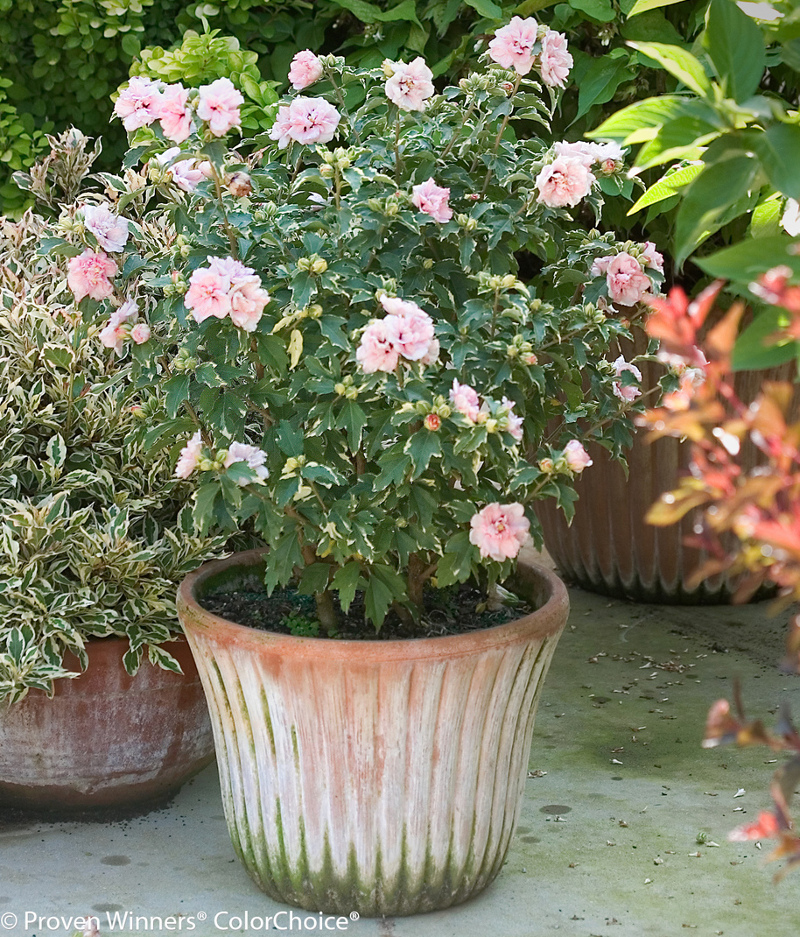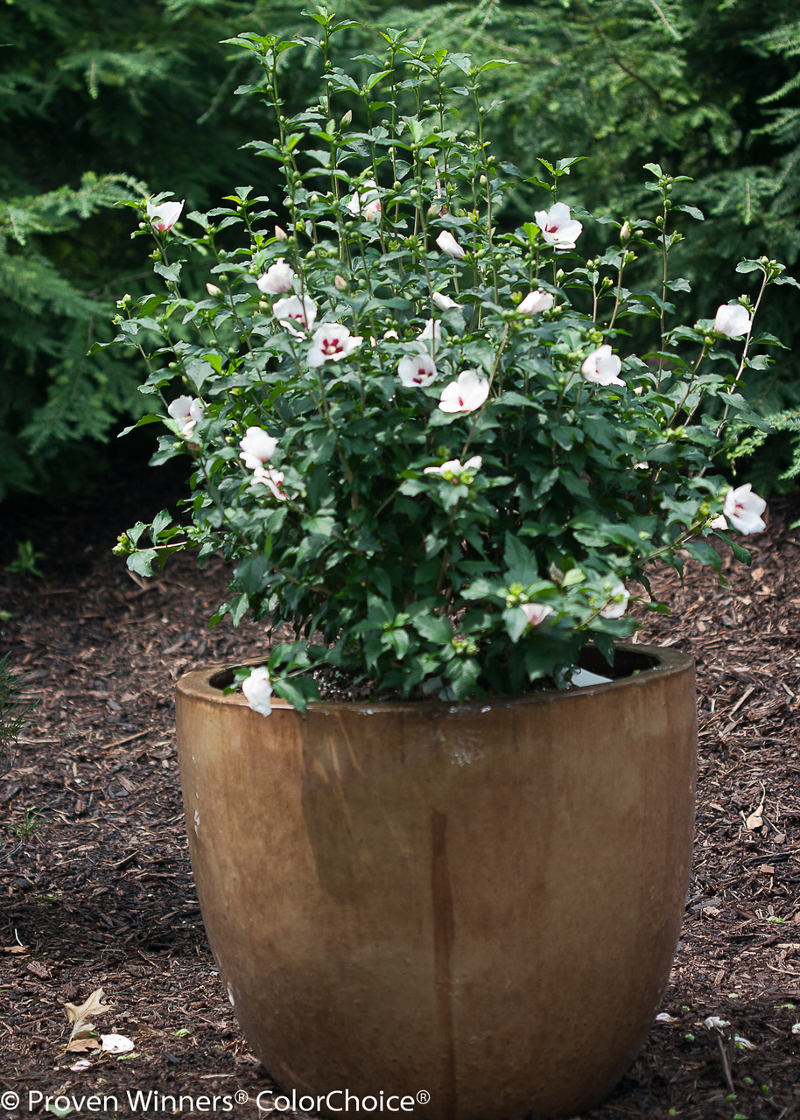Roses of Sharon are large, hearty shrubs that can reach up to 12 feet tall and have long-lasting, exotic-looking flowers in summer that mimic their relatives, tropical hibiscus. But if you don’t have large garden space, you might be wondering, how well does Hibiscus syriacus grow in containers, and for how long?
Breeders have been busy with this popular plant and today there is so much variety available, you can find a rose of Sharon cultivar that stays closer to six feet tall, which would be an easier type to keep in a moderately sized container long-term. If you’re wondering how to keep a rose of Sharon in a container happily, read on for all the skills and tips you need.

Planting Rose of Sharon in Pots
Planting from container to container can happen any time of year, but the plant will undergo less stress when temperatures are above freezing. Start with a compact-sized variety and choose a location for your container in full sun to part shade. Your container should allow from one to three inches around the roots of your rose of Sharon. You’ll need to change pots eventually as the plant’s roots fill up that pot and grow to maturity – or consider root pruning to keep the plant in that original pot.
The planter must have ample drainage holes since rose of Sharon shrubs love excellent drainage around their roots. It can be any material that can withstand your coldest temperatures. Porous materials like unglazed terracotta will improve drainage but will keep the soil thirstier.
As large, upright plants, these woody shrubs are not suitable for window boxes or hanging baskets.
Best Soil for Rose of Sharon in Pots
Roses of Sharon will prefer high-quality, well-draining potting mix for container growing. Because they like drainage so well, avoid mixes including “moisture crystals” which can hold onto water in pools around the root zone, potentially causing rot.
Contrary to common belief, it’s best to use only potting mix all the way through the container, without adding pebbles, pot shards, Styrofoam packing peanuts or other materials. Rather than improving drainage, we now understand adding extra media holds the water at the roots.
Compost and/or mulch, on the other hand could be excellent additions laid on the top of the soil, to let nutrients trickle down and prevent moisture loss at the surface.
Caring for Rose of Sharon in Planters
All plants need extra TLC after transplanting, usually for the first two years in your garden as they become acclimated to its new environment. Containers need more close care than in-ground plants generally, since there is less insulation against weather stress, and it lacks the beneficial insects and nutrients in garden soil. So, your rose of Sharon will want attention especially when young, and especially in small containers which dry out and freeze more quickly.
This can be watering several times a week, and possibly liquid fertilizer through the growing season. In winter, it may need extra protection from freezing temperatures depending on your conditions and the container. If you begin to see the lowest leaves yellow, or the pot soil seems to let water rush through without absorbing, it may be time to move to a larger pot.
Your goal is to keep your rose of Sharon evenly moist, while allowing that moisture to drain away from the roots. So you may need to

Watering Rose of Sharon in Pots
Roses of Sharon are relatively drought-tolerant once established – which usually takes about two years in a location (or a new pot). Until then, the gardener needs to monitor the soil in the container regularly. After that, you’ll still have to watch it more closely than if it were in the ground. As a guideline, expect to water at least twice a week (more for smaller containers, less for very large ones), and more frequently in hot or dry weather.
Because roses of Sharon do not like to be soggy, test the soil with your finger about two inches deep to see if it really needs watering. If your plant’s leaves are yellowing, that can be over- or underwatering, so better to be safe than sorry.
Fertilizing Rose of Sharon in Pots
Because the gardener is providing all the nutrients for potted plants, a good practice is to start the season with a slow-release fertilizer that will gradually feed your plant over several months. Look for balanced nutrient ratios similar to 14-14-14 or 10-10-10. Roses of Sharon don’t like too much fertilizer.
However, container plantings tend to lose fertilizer with each watering, so what to do? Consider supplementing gently with a liquid fertilizer that is readily available to the plant. Apply at half the recommended strength on the package monthly. You may be overdoing it if you see yellow or brown leaves, assuming the soil moisture is good.
Winter Care for Rose of Sharon in Pots
Roses of Sharon are hardy in USDA zones 5 through 9, so if you are gardening in zone 5 or below, you’ll want to give your potted plant some extra protection from freezing winds. Typically locations up against a wall with full sun exposure are toastiest, so you can consider moving your pot if possible.
There are all kinds of ways to protect your plant and your pot and help it overwinter. Water well before a forecasted frost event, and mulch with three inches of bark chips or shredded leaves. Consider wrapping the plant and pot with frost cloth, bubble wrap (taking care that water can still move through the soil) or wire mesh filled with leaves. Remove when freezing temperatures depart.
Bringing the plants indoors is not recommended.
Growing Rose of Sharon Indoors
Rose of Sharon expects cold winter temperatures and a dormant period, so it does not make a good house plant, unlike some of its tropical cousins.
 |
Author Erica Browne Grivas - Published 1-25-2022 |
